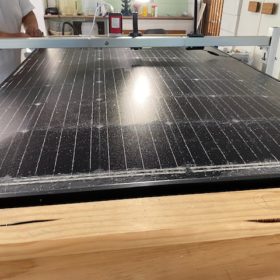
Solarwatt’s Vision glass-glass solar PV modules have pushed the technology’s resilience even further after passing cyclone testing in Darwin, Australia.
Glass-glass and backsheet manufacturers are tussling for the inside track on the bifacial wave, and both have their advantages and disadvantages. For Solarwatt, the leading German manufacturer of Vision glass-glass panels, pushing the technology’s noted resilience is becoming ever-more important, as more panels are installed in ever-trickier conditions.
When pv magazine Australia spoke to DuPont’s Hong-Jie Hu last year, the solar technical and development lead spoke to the differences between backsheets and glass-glass bifacial modules. With bifacial module uptake growing in the Australian marketplace, Hu believes the lighter weight and O&M advantages of transparent backsheets will ensure their market supremacy.
However, like transparent backsheets, glass-glass modules are also seeing technological advancements. The most obvious is the thinning glass – some module makers are using glass only 2mm thick, which is a significant reduction in weight and a disadvantage in installation and transportation compared to transparent backsheets.
Only this week, U.S. researchers at the Massachusetts Institute of Technology (MIT) and the U.S. National Renewable Energy Laboratory (NREL) outlined the case for reducing the thickness of solar wafers from the current industry standard of 160 microns down to 50 microns and even thinner.
A long-held advantage of glass-glass is its ability to survive in the toughest conditions – an advantage which may dissipate if one of the caveats to thinning is brittleness. However, for many parts of the world, the resilience of glass-glass bifacial modules is simply a necessity.
Solarwatt’s vision glass-glass panels were recently approved for Australian cyclone conditions, with performance and resilience results in extreme weather conditions far exceeding its competitors. The tests were carried out by Albright consulting Engineers in Darwin under imitation conditions. The Vision 60M and Vision 60M Style solar modules were able to resist substantial vertical design loads on various mounting supports of up to 6.52 kilopascals (kPa – a recognized measure of pressure and strength).
“These procedures are a recognized test of resistance and ability to withstand cyclones and Solarwatt emerged with a considerably higher score than its nearest competitors,” said Sascha Gotzsch, managing director of Solarwatt Australia.
Glass-glass capable of withstanding significant amounts of pressure is a sign of improvement against cracking, which is one of the leading causes of defects in glass-glass bifacial modules. DuPont observed this in 2018 when it added data from glass-glass installations to its Global Field Study, bowing and breaking into pieces under their own weight. Clearly, Solarwatt has been working to minimize the defects present in glass-glass observed by DuPont.
Of course, the ability to withstand pressure and cyclone winds does not speak to whether glass-glass is not still susceptible to busbar and finger-ribbon corrosion, a leading cause of power loss that DuPont noticed with the delamination of the glass.
It should be noted that at the time of DuPont’s observations that many proponents of glass-glass technology were quick to note that defects present in China may have been the result of developers and manufacturers unfamiliar with the burgeoning technology. Like everywhere in the PV supply chain, there is high- and low-quality. Solarwatt’s glass-glass, as demonstrated by the flying colours it displayed in cyclone condition testing, is certainly on the high-side.
It should also be noted that DuPont’s criticisms of glass-glass were made at the same time it introduced its transparent backsheets to the market at SNEC. Coincidence? Perhaps, though perhaps not for glass-glass manufactures. It is funny to think that there are only ever happy coincidences, for it suggests that coincidence is merely a matter of perspective – such is the relativity of serendipity.
By Blake Matich
Lắp đặt điện mặt trời Khải Minh Tech
https://ift.tt/2X7bF6x
0906633505
info.khaiminhtech@gmail.com
80/39 Trần Quang Diệu, Phường 14, Quận 3
Lắp đặt điện mặt trời Khải Minh Tech
https://ift.tt/2ZH4TRU
Không có nhận xét nào:
Đăng nhận xét